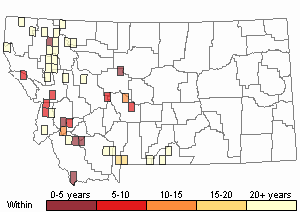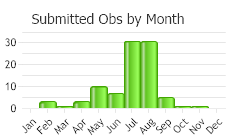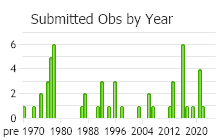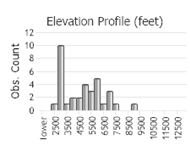View in other NatureServe Network Field Guides
NatureServe
Montana
Utah
Wyoming
Idaho
Wisconsin
British Columbia
South Carolina
Yukon
California
New York
Waterside Feather Moss - Brachythecium rivulare
Other Names:
Brook Mat Moss
General Description
Plants: Pleurocarpous (Vitt 1988). Growing in open to somewhat crowded mats, pale to deep green, green with yellow tones, or ochre (FNA 2014), somewhat or erratically dendroid (Crum and Anderson et al. 1981). Stems prostrate or inclined, leafy, round in X-section, to 15 cm in length, erratically branched to pinnate; possessing a central strand. Branches straight or curved a little, leafy, round in X-section, to 20 mm in length (FNA 2014).
Leaves: Stem leaves flat against the stem (or frequently spreading on sympodial shoots), densely overlapping, widely egg-shaped, cupped, somewhat to not at all longitudinally pleated, cupped, 1.5-2.5 mm in length, 0.8-1.5 mm in width; margins flat or curved back and downward in different locations; base curved, with long, wide decurrencies; apex slowly narrowing, the tip widely acute (seldom acuminate); costa distinct, extending about 1/2-3/4 the length of the leaf. Branch leaves narrower (lance-shaped and somewhat ovate) and spreading more than the stem leaves, the length 2-3 times that of the width (FNA 2014), not or only shortly decurrent (Crum and Anderson et al. 1981).
Stem Leaf Cells: Alar cells highly inflated and fine-walled, short and quadrangular (FNA 2014), forming auricles which extend down the stem (Lawton 1971), the alar area large and well-delineated, from near the edge extending about half the distance to the costa; laminal cells long and thin; basal cells arranged in 3 tiers (FNA 2014).
Branch Leaf Cells: Alar area sometimes indistinct; laminal cells swollen across the leaf bottom (FNA 2014).
Diagnostic Characteristics
Plants influenced by swift currents are rigid and brownish-green rather than soft and pale, whitish green like those plants found near springs (FNA 2014).
Both robust forest species, Brachythecium rivulare has a somewhat tree-like appearance, and the sympodial shoots with their branches are not as crowded as in the similar B. rutabulum. Although both species have inflated alar cells, the alar area of B. rivulare also includes cells that are slender and chlorophyllous near the margin, which B. rutabulum does not (FNA 2014).
Range Comments
North American Range
Found in most states and provinces (unknown in CA, ND, TX, and a few southeastern states) (FNA 2014). In Montana, known from Beaverhead, Carbon, Cascade, Fergus, Flathead, Gallatin, Glacier, Lake, Lewis and Clark, Lincoln, Madison, Missoula, Park, Powell, and Ravalli Counties (Elliott 2016).
Observations in Montana Natural Heritage Program Database
Number of Observations: 97
(Click on the following maps and charts to see full sized version)
Map Help and Descriptions
Relative Density

Recency



 (Observations spanning multiple months or years are excluded from time charts)
(Observations spanning multiple months or years are excluded from time charts)
Habitat
Water-filled low-lying areas amidst otherwise xeric habitat, wet peat in sedge swamps (FNA 2014), wet soil and rocks near streams; often emergent from water (Elliott 2016). Elevation: 0-11,150 feet (FNA 2014).
Reproductive Characteristics
Dioicous. Plants with fruit rare. Perichaetial leaves with base enveloping the stem, the apex squarrose (Lawton 1981). Seta 20-25 mm in length, russet. Capsule slanted to level, egg-shaped or narrowly so, bowed, 2-2.5 mm in length (FNA 2014).
Stewardship Responsibility
References
- Literature Cited AboveLegend:
 View Online Publication
View Online Publication Crum, H.A. and L.E. Anderson. 1981. Mosses of Eastern North America. 2 volumes. Columbia University Press, New York. 1328 pp.
Crum, H.A. and L.E. Anderson. 1981. Mosses of Eastern North America. 2 volumes. Columbia University Press, New York. 1328 pp. Elliott, J.C. and A.K. Pipp. 2018. A Checklist of Montana Mosses (1880-2018). Updated 3 January, 2020. Montana Natural Heritage Program, Helena, Montana. 73 pp.
Elliott, J.C. and A.K. Pipp. 2018. A Checklist of Montana Mosses (1880-2018). Updated 3 January, 2020. Montana Natural Heritage Program, Helena, Montana. 73 pp. Flora of North America Editorial Committee, eds. 2014. Flora of North America North of Mexico. Volume 28. Bryophytes: Mosses, Part 2. Oxford University Press, Inc., NY. xxi + 702 pp.
Flora of North America Editorial Committee, eds. 2014. Flora of North America North of Mexico. Volume 28. Bryophytes: Mosses, Part 2. Oxford University Press, Inc., NY. xxi + 702 pp. Lawton, E. 1971. Moss Flora of the Pacific Northwest. Hattori Botanical Laboratory. Japan: Yamabuki-cho, Shinjuku-ku, Tokyo. 362 pages plus appendices.
Lawton, E. 1971. Moss Flora of the Pacific Northwest. Hattori Botanical Laboratory. Japan: Yamabuki-cho, Shinjuku-ku, Tokyo. 362 pages plus appendices. Vitt, D. J. Marsh, and R. Bovey. 1988. Mosses, Lichens & Ferns of Northwest North America. Seattle, WA: University of Washington Press. 296 p.
Vitt, D. J. Marsh, and R. Bovey. 1988. Mosses, Lichens & Ferns of Northwest North America. Seattle, WA: University of Washington Press. 296 p.
- Additional ReferencesLegend:
 View Online Publication
View Online Publication
Do you know of a citation we're missing? Elliot, J. C. 1993. Second checklist of Montana mosses. Unpublished report. U.S. Forest Service, Region 1. Missoula, MT. 45 pp.
Elliot, J. C. 1993. Second checklist of Montana mosses. Unpublished report. U.S. Forest Service, Region 1. Missoula, MT. 45 pp. Flowers, S. 1973. Mosses: Utah and the West. Brigham Young University, Provo, Utah. 567 p.
Flowers, S. 1973. Mosses: Utah and the West. Brigham Young University, Provo, Utah. 567 p. Lawton, E. 1971. Keys for the Identification of the Mosses on the Pacific Northwest. Reprinted from 'Moss Flora of the Pacific Northwest'. Published as Supplement No. 2 of the Journal of the Hattori Botanical Laboratory. Nichinan, Miyazaki, Japan. 66 pp.
Lawton, E. 1971. Keys for the Identification of the Mosses on the Pacific Northwest. Reprinted from 'Moss Flora of the Pacific Northwest'. Published as Supplement No. 2 of the Journal of the Hattori Botanical Laboratory. Nichinan, Miyazaki, Japan. 66 pp. Smith, A.J.E. 1980. The Moss Flora of Britain and Ireland. Cambridge University Press, Cambridge. 705 pp.
Smith, A.J.E. 1980. The Moss Flora of Britain and Ireland. Cambridge University Press, Cambridge. 705 pp.
- Web Search Engines for Articles on "Waterside Feather Moss"





